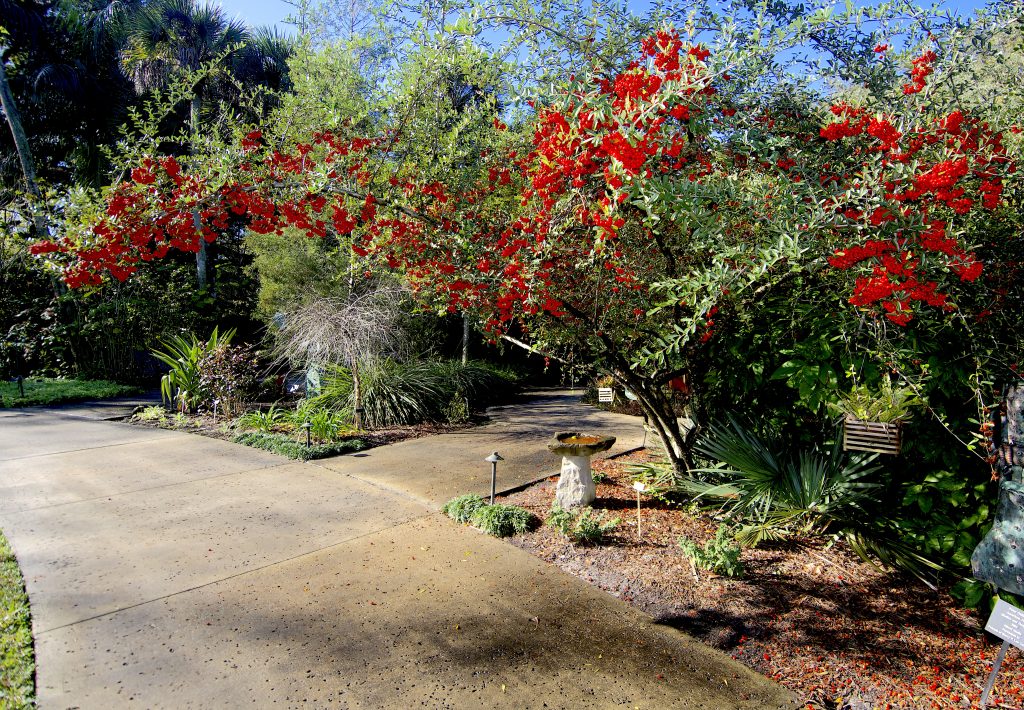
Pyracanthas are showy. Photo by Green Deane
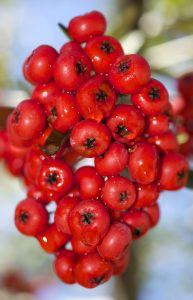
And edible, too. Photo by Green Deane
Pyracanthas are furious in the fall. Their brilliant red berries stand out in every landscape. Like many species in the greater rose family the Pyracantha has a small amount of (glyco-) cyanide in its seeds so they are not eaten. And the pulp of the berry has the texture of an overripe apple with a hint of that pome’s flavor. So they are usually processed into jelly, syrup or even wine. Fortunately we don’t have to remove the seeds before processing the berries. You can cook the berries seeds and all but then you have to strain the seeds out. Also know that while in northern climates the Pyracantha fruits once a year but in warmer climates can fruit twice. To read more about the Pyracantha go here.
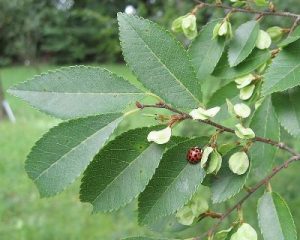
Edible Samaras on the Lace Bark Elm. Photo by Green Deane (The Ladybug is not edible)
Both the Chinese and Siberian Elms have several edible parts. When they start to fruit they make what is called a “samara” (SAM-ah-rah) which is a round paper-like envelop, slightly smaller than a dime. That is edible raw or cooked and the trees are loaded with them. Over time a seed develops in that samara which is about the size of a lentil and can be used the same way. Young leaves are also edible year round as is the cambium. Locally Chinese Elms — also called Lace Bark Elms, the Siberians are more saggy — are numerous, used in landscaping with some naturalization. The Siberian Elm was planted by the millions as part of the Work Project Administration during the depression and are also common in landscaping. To read more about them click here. To see my video on them go here.
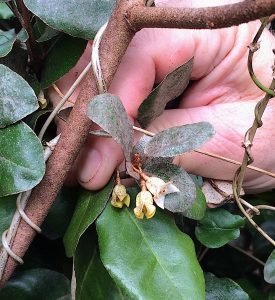
Silverthorns are blossoming now. Photo by Green Deane
Sometimes successful foraging involves identifying the food ahead of time. Around Valentines Day locally the fruit of the Silverthorn is ripe, give or take a few days either way or weeks if the distance is greater. Silverthorn’s blossoms are not extroverted. They are hidden in the shrubbery, odd-shaped and not showy. But over the next six to eight weeks they will turn in to bright red, elongated berries that are sweet and full of the antioxidant lycopene. The edible seeds have Omega 3 fatty acids. Silverthorn is a fairly easy landscaped (and escaped) shrub to find. Its leaves are usually moderate to dark green on top and waxy. The underside of the leaf is an unmistakable silver color with rusty freckles. You can read about them here.
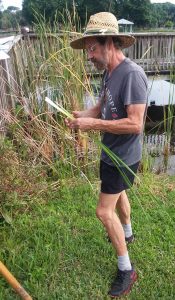
Teaching a foraging class in West Palm Beach. Photo by Nina Kauder.
Foraging Classes: Last week in the newsletter we mentioned that Chickweed should be showing up soon as it is a winter species. As if on cue Chickweed showed up in our foraging class in Gainesville last weekend. That demonstrates our foraging classes are timely (and hands on.) As both of our classes are south of mid-state this week it’s probably not cold enough yet in Sarasota and Ft. Pierce to have chickweed.
Saturday, December 7th, Red Bug Slough Preserve, 5200 Beneva Road, Sarasota, FL, 34233. 9 a.m. to noon. Meet at the play ground.
Sunday, December 8th, George LeStrange Preserve, 4911 Ralls Road, Fort Pierce, FL, 34981. 9 a.m. to noon. Meet at the parking lot. This is a rustic location without water or official bathrooms. Plan accordingly.
Saturday, December 14th, Eagle Park Lake, 1800 Keene Road, Largo, FL 33771. Meet at the pavilion near the dog park. 9 a.m. to noon.
Saturday, December 15th, Blanchard Park, 10501 Jay Blanchard Trail, Orlando, FL 32817. Meet at the picnic area east of the tennis courts. 9 a.m to noon.
Sunday December 22nd, Ft. Meade Outdoor Recreation Area, 1639 Frostproof Highway, Fort Meade, FL 33841. (Frostproof Highway is also Route 98.) 9 a.m to noon. Meet at the second set of bathrooms (in the middle of the park) which is due south from the highway. (Note that is Ft. Meade, not Mead Gardens.)
Saturday December 28th, Bayshore Live Oak Park, Bayshore Drive. Port Charlotte. Meet at the parking lot at the intersection of Bayshore Road and Ganyard Street. 9 a.m. to noon.
Sunday, January 5th, Dreher Park, 1200 Southern Blvd., West Palm Beach, 33405. Meet just north of the science center. 9 a.m. to noon.
To learn more about the classes, to sign up for a class, or to pre-pay for a class go here.
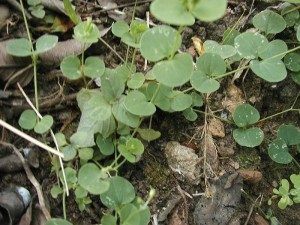
Drymaria is related to Chickweed. Photo by Green Deane
From the Mail Bag: This weed has totally invaded my lawn and I am desperate to get rid of it. Do you have any suggestions? Yes, it was a serious question about an edible, Drymaria cordata. It’s not as edible as regular chickweed and has some medicinal uses, but it is an edible. Thus my advice was: Eat The Weeds! I receive a lot of emails like that. Maybe I should change the website’s name to “Kill The Weeds.” You know a nation is fed when people complain about edible plants in their lawn or you see delicious and nutritious fruit rotting on the sidewalk or around trees. In our last visit to Port Charlotte a Carambola Tree was littering the ground with ripe yellow fruit. At the same location hundreds of Champagne Mangos rot on the ground annually.
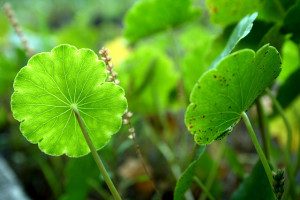
Dollarweed has its stem in the middle.
Botany Builder #30: Peltate, shield-like. When the ancient Greeks fought they did so in a line holding a spear-like pole in the right hand and a round shield in the left held by a handle in the middle. In fact the Greek word for “okay” means “in line.” Usually a peltate leaf has the stem attached to middle on the underside like the common Dollar Weed. Websites say peltate comes from the Dead Latin “Pelta” meaning a small light shield. No. It comes from the older Greek word Peltos meaning shield. Greeks were defending themselves with peltos centuries before the Roman’s came along.
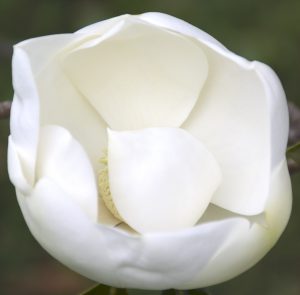
Magnolia petals can be eaten. Photo buy Green Deane
It’s a natural assumption: Blossoms are usually delicate thus they can’t harm you. I know of a local blossom that even a tiny amount ingested will send you to the hospital with gastric distress, perhaps more. And the Mahoe blossoms while edible they are tougher than they look. Hibiscus blossoms usually are pretty but flavorless. But, they do add color and texture to salads. One blossom overlooked for culinary use is the Magnolia, big, showy and very fragrant. I am often asked if the seeds are edible and the answer is not as food. The blossom, however, does have its uses. The petals can be used as a spice. Usually I mince them then semi-pickle them in a sweet and sour solution, read vinegar and sugar. Flower buds can also be used as a spice. But, just as the scent of the blossom is strong so is the spice or relish. Use sparingly or your dish will be too magnoliaesque to consume. To read more about the magnolias go here.
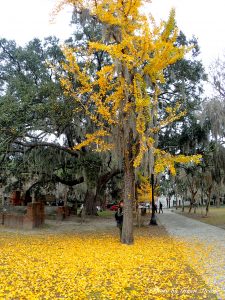
Ginkgo in fall. Photo by Green Deane
Showy and easy to spot in fall foliage is the Ginkgo tree. This Asian native lives to be thousands of years old so identifying exactly when a tree is mature is a bit iffy. However, they do fruit when fairly young. As you might expect all the Ginkgo trees in North American are on the young side but they start fruiting when they are around 12 to 15 feet high. There used to be one in my neighborhood but was removed because it was too close to a fire hydrant. Perhaps moving the hydrant would have been a better long-term decision as the species tends to outlive successive civilizations. Gingko bark resembles an oak and often has a few holes where the insect-eating birds scrounged for lunch. Historically the first US ship to go to China and back was in 1784-85 thus it is doubtful there are any Ginkgo trees more than 330 years old or so in North America. However, some Ginkgo trees were reportedly planted in Augusta, Georgia, as early as 1801-02 in honor of George Washington. To read more about the Ginkgo go here.
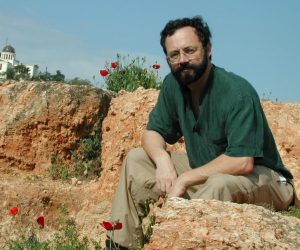
The Nine DVD set includes 135 videos.
Though your foraging may drop off during the winter it’s a great time to study wild edibles with my nine DVD set. Each DVDs has 15 videos for 135 in all. They make a great Christmas gift. Order today. Some of these videos are of better quality than my free ones on the Internet. They are the same videos but many people like to have their own copy. I burn and compile the sets myself so if you have any issues I handle them personally. There are no middle foragers. And I’m working on adding a tenth DVD. To learn more about the DVDs or to order them click here.
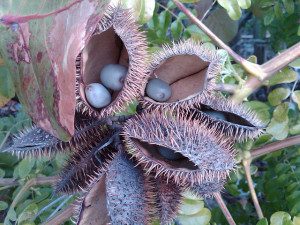
If you read the Green Deane forum you’d know what these are.
Want to identify a plant? Perhaps you’re looking for a foraging reference? You might have a UFO, an Unidentified Flowering Object, you want identified. On the Green Deane Forum we — including Green Deane and others from around the world — chat about foraging all year. And it’s not just about warm-weather plants or just North American flora. Many nations share common weeds so there’s a lot to talk about, such as the one to the left. There’s also more than weeds. The reference section has information for foraging around the world. There are also articles on food preservation, and forgotten skills from making bows to fermenting food. Recent topics include: Asystasia gangetica aka Chinese Violet or Ganges Primrose, Armillaria mellea Ringed Honeys, Acorn Treatment Question, Acorn Questions Any Poisons? A Cure For The Common Cold, Lactifluus piperatus, Elderberry Capers? You can join the forum by clicking on the button on the upper right hand side of this page.
 Donations to upgrade EatTheWeeds.com have gone well. Thank you to all who have contributed to either via the Go Fund Me link, the PayPal donation link or by writing to Green Deane POB 941793 Maitland FL, 32794. There are many needs left such as expanding the foraging teacher page, the page on monotypic edibles and the Plant Archive page. There’s always something and such things get more complex and expensive every year.
Donations to upgrade EatTheWeeds.com have gone well. Thank you to all who have contributed to either via the Go Fund Me link, the PayPal donation link or by writing to Green Deane POB 941793 Maitland FL, 32794. There are many needs left such as expanding the foraging teacher page, the page on monotypic edibles and the Plant Archive page. There’s always something and such things get more complex and expensive every year.

Without bats pollinating Agave there’d be no Tequila.
What’s the word for bee pollination? Melittophily. Butterfly pollination is Psychophily; Moth pollination Phalaenophily; Fly pollination Myophily or Sapromyophily; Beetle Pollination Cantharophily; Wind Pollination Anemophily; Water Pollination Hydrophily; Bird pollination Ornithophily, and Bat pollination Chiropterophily. I could not find a specific word for wasp pollination though they are essential to the fig harvest. In Greek — which all the other words above are from — the wasp is Σφῆκα (sfika, SFEE-kah.) “SF” is not hard to say. Just put an S sound and an F sound together one after the other.) So, if we follow the previous Greek treatments above pollination by wasp would be –directly — sfikophily. That would probably be mangled through Dead Latin into Syphcophily (siff-COUGH-fill-lee.) That’s just an ear guess. And what of vanilla which often pollination by hand? My vote for hand pollination is… Anthrophily as there doesn’t seem to be a word for pollination by human hand.
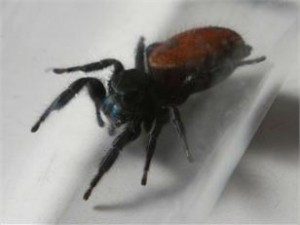
Nefertiti went a long way in life.
Nefertiti, Spidernaut and Mighty Hunter, died of natural causes seven years ago today, December 3rd. She was 10-months old when she passed. Born in Arizona in February 2012, Nefertiti was well-traveled having visited Boulder, Colo., San Francisco, Tokyo and Kagoshima, Japan, the International Space Station, and Washington, D.C, where she retired to the Smithsonian Museum of Natural History. The third spider in space, following Arabella and Anita who became the first spiders to go to space in 1973, Nefertiti flew 42 million miles during her mission. She traveled to the space station July 21 in 2012 aboard an unpiloted HTV-3 cargo carrier launched from Tanegashima, Japan. Nefertiti was housed in a multi-chambered enclosure that included a spider den as well as an isolated compartment for her food, fruit flies. She worked closely with NASA astronaut and Expedition 33 commander Sunita Williams. Nefertiti also made history with her return to Earth descending aboard the first SpaceX Commercial Resupply Services mission, splashing down on Oct. 28 of that year in the Pacific Ocean. Her death was unexpected. Only a week earlier she had moved into her retirement complex at the Smithsonian. Three days before her death she was seen dining on crickets, her favorite food, and looking well. Those who knew her speculated her space travel shortened her life expectancy by two months.
“Nefertiti had some extraordinary stress put on her in her lifetime,” said Dan Babbitt, manager of the Smithsonian insect zoo. “Going up to space, traveling quite a bit, and the media coverage as well. She lived a full life.” Survivors included several hundred brothers and sisters and thousands of nieces and nephews.
This is weekly newsletter 382. If you want to subscribe to this free newsletter you can find the sign-up form in the menu at the top of the page.
To donate to the Green Deane Newsletter click here.

